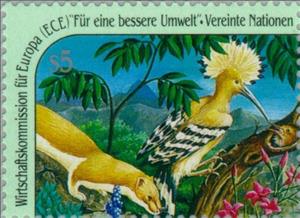Stamp: Eurasian Hoopoe (Upupa epops), Stoat (Mustela ermina) (UNO Vienna 1991)
Eurasian Hoopoe (Upupa epops), Stoat (Mustela ermina) (UNO Vienna 1991)
01 January (UNO Vienna ) within release E.C.E. goes into circulation Stamp Eurasian Hoopoe (Upupa epops), Stoat (Mustela ermina) face value 5 Austrian schilling
| Stamp Eurasian Hoopoe (Upupa epops), Stoat (Mustela ermina) in catalogues | |
|---|---|
| Michel: | Mi:NT-WN 110 |
Stamp is square format.
Also in the issue E.C.E.:
- Stamp - Eurasian Hoopoe (Upupa epops), Stoat (Mustela ermina) face value 5;
- Stamp - Whooper Swan (Cygnus cygnus), Bird face value 5;
- Stamp - European Badger (Meles meles), Red Squirrel (Sciurus vulgari face value 5;
- Stamp - Common Shelduck (Tadorna tadorna), Red-breasted Merganser (M face value 5;
Stamp Eurasian Hoopoe (Upupa epops), Stoat (Mustela ermina) it reflects the thematic directions:
Birds (Aves), a subgroup of Reptiles, are the last living examples of Dinosaurs. They are a group of endothermic vertebrates, characterised by feathers, toothless beaked jaws, the laying of hard-shelled eggs, a high metabolic rate, a four-chambered heart, and a strong yet lightweight skeleton. Birds live worldwide and range in size from the 5 cm (2 in) bee hummingbird to the 2.75 m (9 ft) ostrich. They rank as the class of tetrapods with the most living species, at approximately ten thousand, with more than half of these being passerines, sometimes known as perching birds. Birds are the closest living relatives of crocodilians.
Mammals are any vertebrates within the class Mammalia (/məˈmeɪli.ə/ from Latin mamma "breast"), a clade of endothermic amniotes distinguished from reptiles (including birds) by the possession of a neocortex (a region of the brain), hair, three middle ear bones and mammary glands. All female mammals nurse their young with milk, secreted from the mammary glands. Mammals include the largest animals on the planet, the great whales. The basic body type is a terrestrial quadruped, but some mammals are adapted for life at sea, in the air, in trees, underground or on two legs. The largest group of mammals, the placentals, have a placenta, which enables the feeding of the fetus during gestation. Mammals range in size from the 30–40 mm (1.2–1.6 in) bumblebee bat to the 30-meter (98 ft) blue whale. With the exception of the five species of monotreme (egg-laying mammals), all modern mammals give birth to live young. Most mammals, including the six most species-rich orders, belong to the placental group. The largest orders are the rodents, bats and Soricomorpha (shrews and allies). The next three biggest orders, depending on the biological classification scheme used, are the Primates (apes and monkeys), the Cetartiodactyla (whales and even-toed ungulates), and the Carnivora (cats, dogs, seals, and allies).
Animals are multicellular, eukaryotic organisms of the kingdom Animalia (also called Metazoa). All animals are motile, meaning they can move spontaneously and independently, at some point in their lives. Their body plan eventually becomes fixed as they develop, although some undergo a process of metamorphosis later on in their lives. All animals are heterotrophs: they must ingest other organisms or their products for sustenance.
Flora is the plant life occurring in a particular region or time, generally the naturally occurring or indigenous—native plant life. The corresponding term for animal life is fauna. Flora, fauna and other forms of life such as fungi are collectively referred to as biota. Sometimes bacteria and fungi are also referred to as flora, as in the terms gut flora or skin flora.




